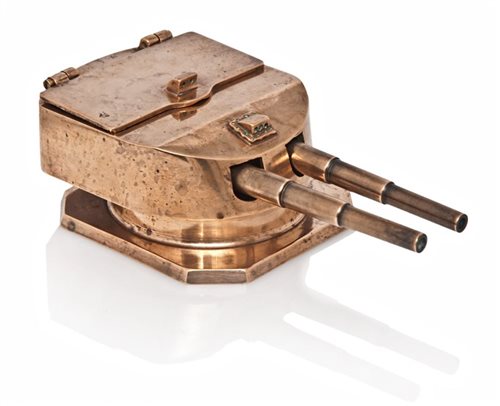12th May, 2015 12:00
Maritime and Scientific Models, Instruments & Art (Sandwich)
138
[M] A 1920s MODEL GUN TURRET FROM METAL OFF THE...
A 1920s MODEL GUN TURRET FROM METAL OFF THE SCUTTLED IMPERIAL GERMAN BATTLESHIP HELGOLAND
the well-made model fashioned as an inkstand in the form of a revolving gun turret, the inner lid marked "Cast from Metal ex-surrendered German Battleship Helgoland", Thos. W. Ward Ltd., Sheffield, 1922, lacking one (of the two) ink reservoirs but otherwise an attractive item, extreme width -- 7½ins. (19cms.)
Helgoland was the nameship of a small class of three battleships and one battle-cruiser ordered for the Imperial Navy during the celebrated Anglo-German 'Arms Race' of the early twentieth century. Built at Kiel, Helgoland herself was 549 feet in length with a 94 foot beam and displaced 25,200 tons deep loaded. With a main armament of 12-12in. guns, she could cruise at 20 knots and must have been a hugely impressive sight at full speed. In action at Jutland, in Vice-Admiral Schmidt's 1st Squadron, she was interned at Scapa Flow when the High Sea's fleet surrendered after the November 1918 Armistice. Laid up idle for six months, Helgoland was scuttled along with the rest of the fleet on 21st June 1919, after which began the famous salvage operation which lasted throughout the 1920s.
the well-made model fashioned as an inkstand in the form of a revolving gun turret, the inner lid marked "Cast from Metal ex-surrendered German Battleship Helgoland", Thos. W. Ward Ltd., Sheffield, 1922, lacking one (of the two) ink reservoirs but otherwise an attractive item, extreme width -- 7½ins. (19cms.)
Helgoland was the nameship of a small class of three battleships and one battle-cruiser ordered for the Imperial Navy during the celebrated Anglo-German 'Arms Race' of the early twentieth century. Built at Kiel, Helgoland herself was 549 feet in length with a 94 foot beam and displaced 25,200 tons deep loaded. With a main armament of 12-12in. guns, she could cruise at 20 knots and must have been a hugely impressive sight at full speed. In action at Jutland, in Vice-Admiral Schmidt's 1st Squadron, she was interned at Scapa Flow when the High Sea's fleet surrendered after the November 1918 Armistice. Laid up idle for six months, Helgoland was scuttled along with the rest of the fleet on 21st June 1919, after which began the famous salvage operation which lasted throughout the 1920s.
Sold for £645
Estimated at £400 - £600
(inc. buyer's premium of 24%)
A 1920s MODEL GUN TURRET FROM METAL OFF THE SCUTTLED IMPERIAL GERMAN BATTLESHIP HELGOLAND
the well-made model fashioned as an inkstand in the form of a revolving gun turret, the inner lid marked "Cast from Metal ex-surrendered German Battleship Helgoland", Thos. W. Ward Ltd., Sheffield, 1922, lacking one (of the two) ink reservoirs but otherwise an attractive item, extreme width -- 7½ins. (19cms.)
Helgoland was the nameship of a small class of three battleships and one battle-cruiser ordered for the Imperial Navy during the celebrated Anglo-German 'Arms Race' of the early twentieth century. Built at Kiel, Helgoland herself was 549 feet in length with a 94 foot beam and displaced 25,200 tons deep loaded. With a main armament of 12-12in. guns, she could cruise at 20 knots and must have been a hugely impressive sight at full speed. In action at Jutland, in Vice-Admiral Schmidt's 1st Squadron, she was interned at Scapa Flow when the High Sea's fleet surrendered after the November 1918 Armistice. Laid up idle for six months, Helgoland was scuttled along with the rest of the fleet on 21st June 1919, after which began the famous salvage operation which lasted throughout the 1920s.
the well-made model fashioned as an inkstand in the form of a revolving gun turret, the inner lid marked "Cast from Metal ex-surrendered German Battleship Helgoland", Thos. W. Ward Ltd., Sheffield, 1922, lacking one (of the two) ink reservoirs but otherwise an attractive item, extreme width -- 7½ins. (19cms.)
Helgoland was the nameship of a small class of three battleships and one battle-cruiser ordered for the Imperial Navy during the celebrated Anglo-German 'Arms Race' of the early twentieth century. Built at Kiel, Helgoland herself was 549 feet in length with a 94 foot beam and displaced 25,200 tons deep loaded. With a main armament of 12-12in. guns, she could cruise at 20 knots and must have been a hugely impressive sight at full speed. In action at Jutland, in Vice-Admiral Schmidt's 1st Squadron, she was interned at Scapa Flow when the High Sea's fleet surrendered after the November 1918 Armistice. Laid up idle for six months, Helgoland was scuttled along with the rest of the fleet on 21st June 1919, after which began the famous salvage operation which lasted throughout the 1920s.
Auction: Maritime and Scientific Models, Instruments & Art (Sandwich), 12th May, 2015
